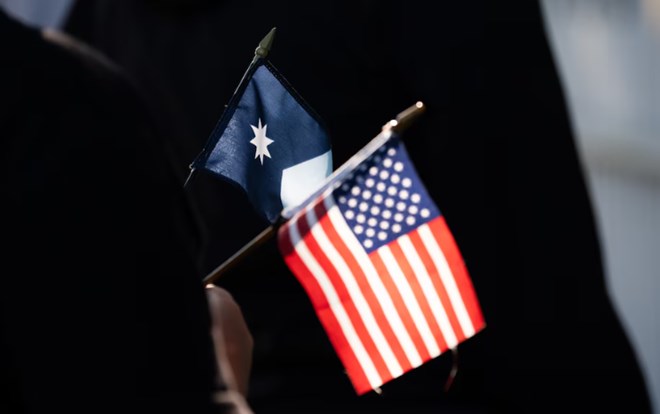
Column by Philip Bump
Thursday August 8, 2024
The false claim is another product of the right’s conspiratorial social media bubble.

Someone holds Minnesota and American flags in front of Minnesota Gov. Tim Walz's temporary governor's residence in St. Paul, Minn., on Tuesday. (Stephen Maturen/Getty Images)
In 2001, the North American Vexillological Association — an organization of flag enthusiasts — conducted a poll asking its members to rank the official flag of each American state and Canadian province.
The most-liked flags were those from New Mexico and Texas, simple flags with broad expanses of color and singular graphical elements. The least-liked were a coterie of similar flags, big fields of color with the state seal (or some equivalently complicated graphic) plunked down in the middle. Of the 72 flags that were considered, Utah’s flag ranked 58th. Minnesota’s ranked a miserable 67th.
A bit over two decades later, Utah unveiled a new flag, stripped of the state seal in favor of a large beehive, a state symbol representing its motto, “Industry.” And earlier this year, Minnesota unveiled a new flag of its own.
The new flag has three elements, two fields of color and an eight-pointed star. In a report detailing the new flag (and an accompanying update to the state seal), the commission tasked with the redesign explained the significance of each. The dark blue represents “the night sky and the shape of the state of Minnesota.” The bright blue is a representation of Minnesota’s 11,800-plus lakes. The star is a reflection of the state motto — the North Star State — and a reflection of an eight-pointed star on the floor of the rotunda of the state capitol.
Minnesota's new state flag. (State of Minnesota)
None of these elements should be particularly surprising. Minnesota used to be home to the basketball Lakers and the hockey (North) Stars, both reflections of the importance of these symbols in the state.
What the flag is not is some paean to the nation of Somalia.
As you are no doubt aware, Vice President Kamala Harris on Tuesday tapped Minnesota Gov. Tim Walz (D) to be her running mate as she seeks the presidency. That led to a flurry of social media disparagements of the newly high-profile governor, including one that burbled up when the new flag was announced: The new Minnesota state flag was somehow meant to evoke Somalia’s, a woke tribute to the state’s large Somali population.
The reality — as is often the case with reality — is more banal and less nefarious.
In 2023, a state legislator from a suburb of Minneapolis (one that doesn’t have a significant Somali population) proposed revamping the state’s iconography. Speaking to a local news outlet, state Rep. Mike Freiberg (D) explained that the old flag, adopted in 1957, was not one that the state’s residents could embrace. That was in part because the seal at the center depicted a farmer tilling a field, with a Native American riding on a horse in the background.
“It was designed very deliberately to depict White farmers displacing Native Americans,” Freiberg explained to CCX Media. “So it’s just not something that’s distinctive. It’s just not something that … I’m proud of.”
His bill calling for a new design passed the state legislature and was signed into law by Walz. It created a commission of Minnesotans and experts that would take submissions and decide on a new design.
The new flag is a modification of one submitted by Andrew Prekker, a resident of the small town of Luverne near the South Dakota border. It had a slightly different eight-pointed star and the light blue section was instead stripes of white, green and blue, but the design was otherwise the same.
“Each color was chosen to symbolize a different important aspect of Minnesota and its identity,” Prekker explained to Minnesota Public Radio. “For the stripes, white represents snow/winter, the green stripe represents our beautiful nature and the importance of agriculture and the light blue stripe represents the several significant meanings of water to our state.”
The existing flag, he said, was “a problematic representation of our state. It’s not a unifying symbol for everyone, and I wanted to create a flag that our Indigenous communities and tribal nations could see representation in as well.”
The modified design became the official flag of Minnesota in May. Even before then, though, the comparison to Somalia’s flag had been drawn.
On social media, state Rep. Natalie Zeleznikar (R) compared Prekker’s original design to ones from regions of Somalia. (It’s worth noting that the comparison depended on altering Prekker’s design significantly.) After the revised flag was adopted, the comparison drawn by critics — generally on the political right — was to Somalia’s national flag. It features a five-pointed star on a light-blue background.
In other words, the comparison depends on two elements that are omnipresent in flag designs: stars and the color blue.
After Walz was selected by Harris, the idea that the new flag was derived from Somalia’s gained new traction — as did the idea that somehow Walz was the person making the decision. (Again, the choice was made by the committee created under Freiberg’s legislation.) On X, owner Elon Musk offered his familiar “hmm, something to think about” emoji in response to a claim that the flag was related to Somalia’s.
The post to which he was responding was explicit in the reason for making the false claim: It’s an effort to cast Walz (and before his selection by Harris, the left in general) as anti-American, as beholden to immigrants from a country that is often presented as dangerous. (Somalia was one of the countries included in Donald Trump’s original travel ban.)
In the past, such nonsense would be relegated to the fringe of the political conversation and not elevated by prominent voices. But this is the present, in which false, pejorative claims are a form of currency on the right, particularly when targeting prominent politicians on the left. So the “Somali flag” claim gets new traction.
It’s also a reflection of a broader trend: taking an earnest, thoughtful community process aimed at rectifying a cultural (and vexillological) wrong and presenting it instead as nefarious and toxic. This case is exceptional only in how obviously and immediately divergent from reality that presentation is.